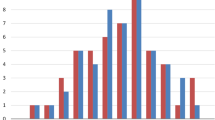Summary
The supposition regarding sex-linked differences in height and surface area of the mastoid process was tested in 105 human skulls, 61 of which were male and 44 were female. There was no statistically significant difference noted in the mean values of the lateral and medial measurements of the processes from both sexes. Some significance, however, was noted in the measurement of the surface area. This may be associated with the insertion of stronger lateral neck-musculature, as is isually the case in males.
Zusammenfassung
An 105 Individuen, 61 männlichen und 44 weiblichen, wird die Behauptung eines Geschlechtsdimorphismus hinsichtlich der Höhe und Größe der Processus mastoidei statistisch nachgeprüft. Für die mediale und laterale Fortsatzhöhe lassen sich keine signifikanten Mittelwertsdifferenzen aufzeigen. Zudem ist die Varianz der Kollektive so groß, daß der Proc. mastoid. als Identifikationsmerkmal ausscheidet. Die gefundene Mittelwertsdifferenz der Größe der Fortsätze, hier durch die äußere Fläche ausgedrückt, läßt sich statistisch eindeutig sichern. Dies entspräche der Vorstellung einer Kausalbeziehung zwischen Ausbildung und Insertion der seitlichen Halsmuskulatur einerseits und Größe bzw. Volumen der Fortsätze andererseits.
Similar content being viewed by others

Literatur
Ashton, E. H., Zuckerman, S.: The mastoid process in the chimpanzee and gorilla. Amer. J. Phys. Anthrop. 10, 145 (1952).
Broca, P.: Zit. nach Martin-Saller.
Culbert, W. D., Law, F. M.: Identification by comparison of roentgenograms. J. Amer. med. Ass. 88, 1634 (1927).
Goth, W.: Vergleichende anatomische Untersuchungen zur Frage der Entstehung des Warzenfortsatzes beim Menschen und den Menschenaffen. Morph. Jb. 79, 547 (1937).
Law, F. M.: Roentgenograms as a means of identification. Amer. J. Surg. 26, 195 (1934).
Martin, A., Saller, K.: Lehrbuch der Anthropologie. Stuttgart: G. Fischer 1957.
Schultz, A. H.: Anthropologische Untersuchungen an der Schädelbasis. Arch. Anthropol. 16, 1 (1917).
— Morphological observations on gorillas. The Henry Cushier Raven memorial volume: The anatomy of the gorilla. New York: Columbia Univ. Press 1950.
— Über das Wachstum der Warzenfortsätze beim Menschen und den Menschenaffen. Homo 3, 105 (1952).
Simpson, G. G., Roe, A., Lewontin, R. C.: Quantitative zoology. New York: Harcourt, Brace & World, Inc. 1960.
Author information
Authors and Affiliations
Rights and permissions
About this article
Cite this article
Schmitt, H.P., Saternus, K. Beiträge zur forensischen Osteologie. Z Rechtsmed 67, 170–174 (1970). https://doi.org/10.1007/BF00200356
Received:
Issue Date:
DOI: https://doi.org/10.1007/BF00200356



